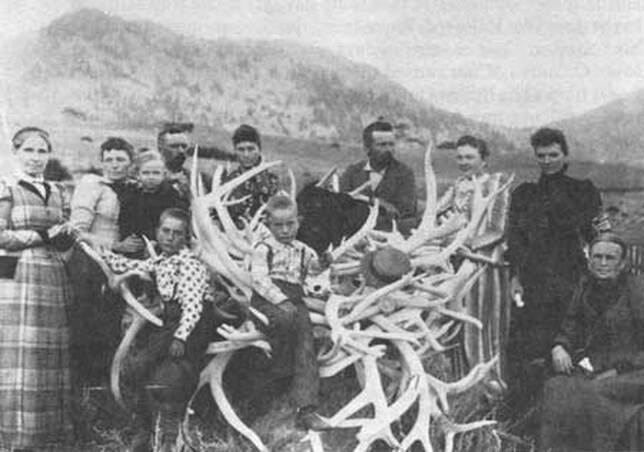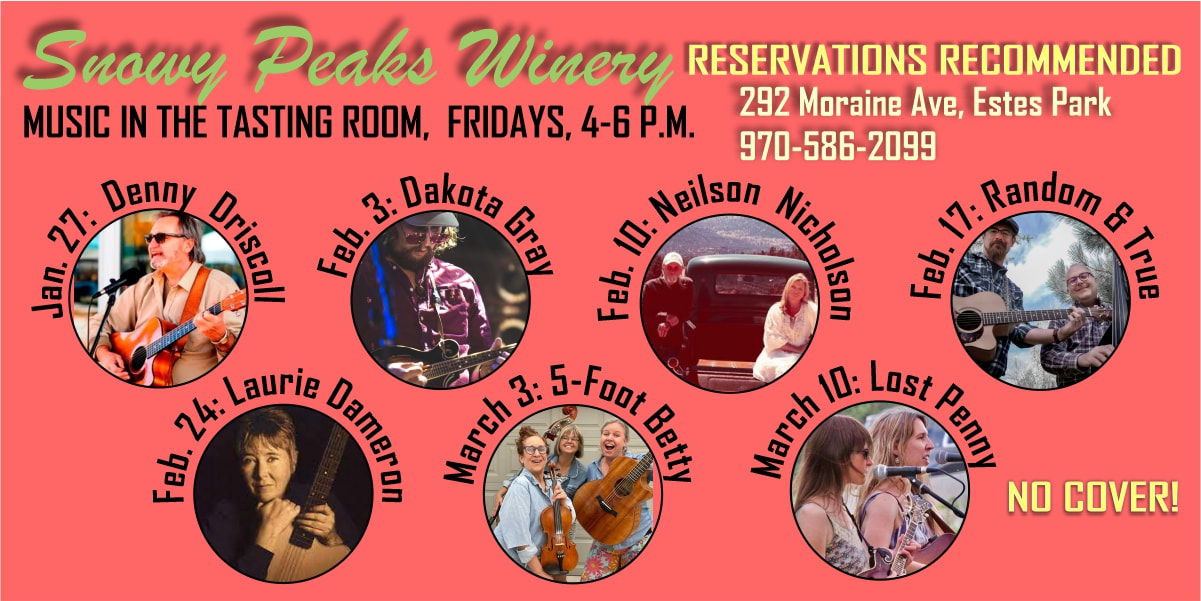|
Research & story by Hillary Eichinger 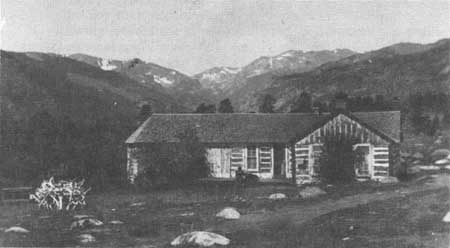 Sprague family homestead in Moraine Park; NPS photo Sprague family homestead in Moraine Park; NPS photo Winter in the Rocky Mountains is harsh, often bringing sub- zero temperatures, frequent storms and high winds. Elk, deer and moose will move down to lower elevations during storms and freezing winds. So why then did early people continue to come back or choose to stay? The easy answer is the abundance of resources and vast sweeping landscapes. Fresh water, abundant wildlife and many wild edible plants attracted people to the dense terrain and high peaks. The Rockies, although severe during winter, provided enough food during the summer and fall to sustain human life. There have been people in the Rocky Mountains and surrounding foothills for more than two thousand years. The Ute Nation believed the creator god Sinawav (Sinauf) specifically placed them in the Rocky Mountains and at Mesa Verde as the chosen people while distributing the other groups of people around the globe. They were to be stewards of the land forming a close relationship to the seasons and changes of the area. The Ute people are not considered nomadic because they returned to the same places, year after year, depending on the season. The area from Denver and Cortez to the east, most of Rocky Mountain National Park and west to Northern Utah, and south to what today is Northern New Mexico were part of their territory. They defended the area fiercely but did not inherently seek battles with other indigenous people that would sometimes include the Arapaho, Cheyenne, Shoshone, and Navajo nations. They traded with Pueblo peoples in New Mexico for pottery to be used in food storage for winter. 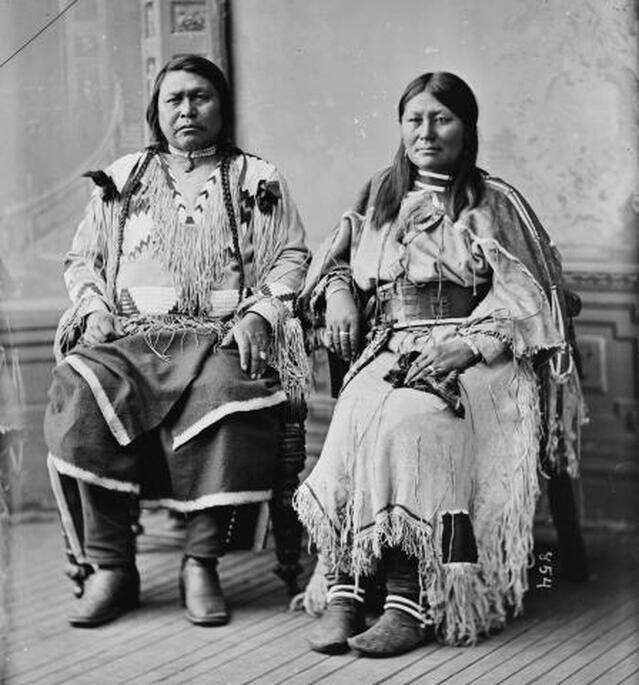 “Chief Ouray, pictured here with his wife Chipeta, was one of the most influential leaders of the Northern Ute people in the late nineteenth century. A known intellectual and skilled diplomat, Ouray negotiated treaties and attempted to avoid conflict with whites wherever possible.” (coloradoencyclopedia.org) During the spring and summer months. the Northern Ute bands would break up into family units to return to certain wild crops and hunting grounds. They remembered specific berry bushes, seeded meadows, good places for fishing, and small game hunting areas to return to every year. They also planted seasonal crops like corn, western potato and squashes. The small family groups were careful not to overtax the land, making sure to not take an entire crop or overuse the soil. By leaving some food behind for Mother Nature to recover or for animals to eat, they cultivated the edible resources they would return to. The Northern Utes believed that they were owned by the land, rather than the other way around. They gathered wild mountain foods including chokecherries, wild raspberries, seeds from grasses and trees, pinenuts, and dried crickets. The yucca plant was very important as it was used for basket making, tea, pulp cakes and medicine. The inner bark of the ponderosa pine was harvested for its medicinal properties. It could be used as a compress, to fight infections and as a healing tea. The men would fish and hunt large game such as deer and elk while the women trapped small game like rabbits and ground squirrels and gathered wild berries and seeds. Bison were not hunted in abundance by the Ute Nation until after 1600, when they acquired horses from the Spanish.  Wikiup/NPS photo Wikiup/NPS photo During the late fall when the weather would start to turn cold, they would travel out of the mountains and meet up with other families. The large number of people allowed more protection from hungry predators and attacks from other tribes looking to get quick resources in the winter. The entirety of the band would gather together for the winter months in a few carefully chosen locations. The Northern Ute bands would camp along the White, Green, and Colorado Rivers in what is now known as Utah. This was a time of rejuvenation, food sharing and crafting. Elders would tell stories, pass on traditions, and arranging marriages. Women would make clothing, spending hours on intricate beading patterns that became famous and highly sought after among other tribes. Clothing and moccasins were typically made from animal hides, most often deer and rabbit. Families would stay together for the deep winter until the bear ceremony in the spring, which marked the time when the hibernating bears would wake up and Mother Nature was ready to start a new cycle. The deep winter months in the Rocky Mountains remained empty of humans until the early homesteaders and pioneers built homes on top of the Ute summer sites. The Spanish saw the land of the Utes was full of resources that they valued such as wild game, timber, and fresh water. Because of the harsh weather conditions, rough terrain, and Ute occupation, white settlers did not arrive until 1860 when Joel Estes stumbled on the valley while hunting for a gold deposit. He “claimed” the land by squatting and building two cabins that he and his family used year round. Later he brought up a herd of cattle that had to be watched and guarded constantly from indigenous hunting groups and predators. The ground froze solid in the upper elevations and the cattle had to be brought in close to the cabins to protect them from winter storms and mountain lions. Estes made a small fortune by selling wild game meat in the winter months. He would haul as much meat as he could down the mountain and sell it to the hungry miners prospecting at the base of the mountains in Denver and Golden. Most of the farming work was accomplished in the short summer months and the fall. Hay had to be grown in abundance and stored to last the cattle through the winter. The Estes family relied on stored food, dried meat, and salted fish. The demand was so high for meat that a writing by Milton Estes, Joel's son, reported that he personally shot and killed one hundred elk during a summer and fall season to sell. The trip down to Denver would take four days and then another four back laden with provisions. By the winter of 1864-1865 the weather and living conditions were so severe that the Estes family decided to leave. That winter, Milton Estes described how the snow started in late November and did not thaw until spring. They had to dig through two feet of snow to reach grass to feed the cattle. That year they had to move the cattle down the mountain to save the herd from starvation. Joel sold his claim for a yolk of oxen to a man named Buck in 1866 and in April, the family left, never to return. They settled in southern Colorado and established a ranch where the weather was milder and there was more room for the cattle. News of the Estes family’s valley and beautiful mountain meadows reached other homesteaders and ranchers. Using the trails established by the Ute and other indigenous people, pioneers started ranches, homesteads, farms and timber camps. Once silver and important minerals were found in the Rockies, more mining camps and quarries were established. Lord Dunraven was the first to enthusiastically enter what was now named Estes Park to hunt and attempt to own land for recreation. Winter enthusiasts and mountaineers streamed to the area to enjoy what was described by Lord Dunraven as “long spells of good winter weather interrupted by frequent storms.” Despite the frigid temperatures, intense storms and harsh terrain, pioneers and homesteaders made time for the holidays. Abner Sprague, later to be a land owner himself in what is today Moraine Park, spent two days hiking high into the mountains with a friend to obtain a Christmas tree. The tree was brought back to the community hall in a wagon filled with hay. They put presents that had been obtained in Denver and stashed for months around the tree for Christmas. In Grand Lake in 1883 the Fairview House hosted a New Year’s Eve party. Everyone in the community was invited and a horse-drawn sleigh was sent out to gather anyone who couldn't otherwise make the trek. They enjoyed a large dinner that started at 10 pm and ended with a toast at midnight. Dancing was a popular holiday pastime that people looked forward to it all year. That night they danced until dawn when it was safe to travel again. “The party opened and closed with all joining hands and dancing around the central Christmas tree.” (Grand Lake in the Olden Days, pg 169) Today there are nearly six thousand year-round residents that enjoy winter in Estes Park. Visitors come to Rocky in the winter to snowshoe, hike, and backcountry ski - some of the same activities the pioneers and early native people did. To find out more about native Colorado people and early pioneers, consult these excellent resources: Estes Park a Quick History, Kenneth Jessen, 1996 The Utes, the Mountain People, Jan Pettit, 1990 My pioneer Life, Abner E Sprague, 1999 Early Estes Park Narratives, Milton Estes, 2005 Grand Lake in the Olden Days, Mary Lions Cairns, 1971 https://www.southernute-nsn.gov/history/ute-creation- story/ https://utahindians.org/archives/ute/earlyPeoples.html 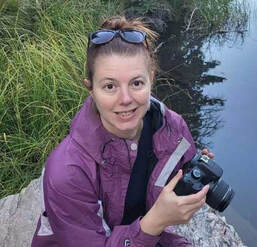 Hillary Eichinger was born and raised in Oregon. She received a bachelor's degree in history and a master's degree in museum studies. she has worked with artists in gallery and museum projects for over 20 years. She is passionate about art, history, photography and natural preservation. This piece of independent and local journalism was made possible by Snowy Peaks Winery and MacDonald Bookshop/Inkwell & Brew.
1 Comment
Bobbie Rice
2/15/2023 08:58:56 pm
We used to vacation in Estes for many years. My husband began coming to Estes when he was little. A relative worked in Denver at the time. He came frequently for years. We were out there for years too
Reply
Leave a Reply. |
Categories
All
|
© Copyright 2025 Barefoot Publications, All Rights Reserved

